|
There are several types of cavitation, which can be classified according to the way in which it occurs, according to its degree of development and according to its morphology.
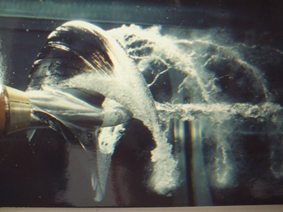
|
|
|
|
STEAM CAVITATION
It occurs due to the local decrease in pressure within a liquid. This can be of two types: hydrodynamic or acoustic.
- Hydrodynamics: created by local depressions due to the acceleration of the fluid.
- Acoustics: due to pressure waves transmitted in the fluid.
|

|
|
|
|
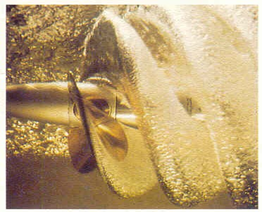
|
GAS CAVITATION
It is caused by the introduction from the outside of energy at points in the liquid (increase in temperature). It can also be called optical cavitation or particle cavitation.
|
|
|
|
INCIPIENT CAVITATION
Initial stage of cavitation in which the formation of bubbles begins to be visible.
|

|
|
DEVELOPED CAVITATION
It is a stage in which there is a number of bubbles high enough to produce a modification of the hydrodynamic field.
|
|
|
|
SEPARATE CAVITATION
Final stage of cavitation, when it is about to disappear. It normally occurs in wake zones, with less importance than the previous ones.
|
|
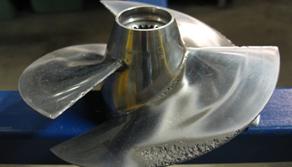
|
SUPERCAVITATION
When there is a submerged solid surface, cavitation spreads, occupying the entire surface. It appears, for example, in speedboat propellers where cavitation conditions are critical. Propel a body underwater requires a large amount of energy. Moving quickly consumes even more energy, since the resistance to the movement of water against a submerged surface increases with speed. Supercavitation is the extreme version of cavitation in which a single bubble forms in such a way that it almost completely engulfs the moving object.
|
|
ISOLATED BUBBLE CAVITATION
It appears as individual, fairly large, rapidly shrinking bubbles on the blade surface. This type of cavitation usually occurs in the area of maximum thickness of the cylindrical sections, where bubbles are formed that collapse violently. It is very dangerous due to the erosion that it can cause to the blades. Its appearance is an indication that the ratio between the thickness of the section where it occurs and its length is too high.
|
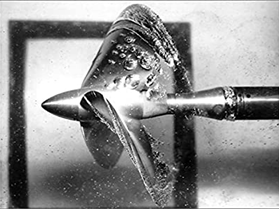
|
|
|
|
CLOUD CAVITATION
It appears when a large surface of the blade cavitates in the form of a bubble. This type of cavitation usually occurs in association with sheet cavitation, when high-velocity vortices appear in the separated flow at the inlet edge, causing small vapor bubbles, and when the flow is restored over the blade before the outlet edge, these bubbles can collapse, giving rise to erosion phenomena. This type of cavitation entails a serious risk of erosion on the surface of the blades and it is necessary to modify its design to prevent its appearance.
|
|
|
|

|
SHEET CAVITATION
It is generated at the inlet edges of the blades on their suction face, which has a positive effect. It is usually stable, although if it reaches conditions of instability it can give rise to strong tensions.
|
|
|
|
STRETCH CAVITATION
Type of bubble cavitation, in which the nucleation of the bubbles occurs following a line.
|
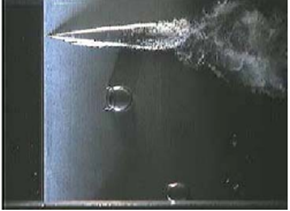
|
|
WHIRLWIND CAVITATION AT THE END OF THE BLADE
It is observed at a certain distance from the tips of the propeller blades. At that time, they are considered separate, but as they get stronger, either from the load or pressure at the top of the blade or decrease in the number of cavitations, it moves towards the tip of the blade and eventually sticks to it.
|
|
|
|
VORTEX CAVITATION
They occur both at the tip and at the hub of the propeller blades. They appear in the form of vorticity tubes with the appearance of cords at the tip of each of the blades or in the center of the propeller, respectively.
|
|

|